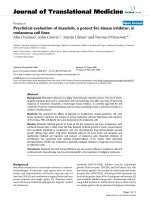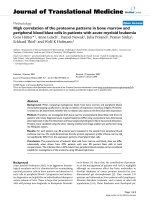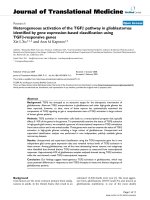báo cáo hóa học:" Nodal solutions of second-order two-point boundary value problems" potx
Bạn đang xem bản rút gọn của tài liệu. Xem và tải ngay bản đầy đủ của tài liệu tại đây (367.54 KB, 17 trang )
This Provisional PDF corresponds to the article as it appeared upon acceptance. Fully formatted
PDF and full text (HTML) versions will be made available soon.
Nodal solutions of second-order two-point boundary value problems
Boundary Value Problems 2012, 2012:13 doi:10.1186/1687-2770-2012-13
Ruyun Ma ()
Bianxia Yang ()
Guowei Dai ()
ISSN 1687-2770
Article type Research
Submission date 16 August 2011
Acceptance date 10 February 2012
Publication date 10 February 2012
Article URL />This peer-reviewed article was published immediately upon acceptance. It can be downloaded,
printed and distributed freely for any purposes (see copyright notice below).
For information about publishing your research in Boundary Value Problems go to
/>For information about other SpringerOpen publications go to
Boundary Value Problems
© 2012 Ma et al. ; licensee Springer.
This is an open access article distributed under the terms of the Creative Commons Attribution License ( />which permits unrestricted use, distribution, and reproduction in any medium, provided the original work is properly cited.
Nodal solutions of second-order two-point boundary value problems
Ruyun Ma, Bianxia Yang and Guowei Dai
∗
Department of Mathematics, Northwest Normal University,
Lanzhou 730070, P. R. China
∗
Corresponding author:
Abstract
We shall study the existence and multiplicity of nodal solutions of the nonlinear second-order two-point
b oundary value problems,
u
+ f(t, u) = 0, t ∈ (0, 1), u(0) = u(1) = 0.
The proof of our main results is based up on bifurcation techniques.
Mathematics Subject Classifications: 34B07; 34C10; 34C23.
Keywords: nodal solutions; bifurcation.
1 Introduction
In [1], Ma and Thompson were considered with determining interval of µ, in which there exist nodal
solutions for the boundary value problem (BVP)
u
(t) + µw(t)f(u) = 0, t ∈ (0, 1), u(0) = u(1) = 0 (1.1)
1
under the assumptions:
(C1) w(·) ∈ C([0, 1], [0, ∞)) and does not vanish identically on any subinterval of [0, 1];
(C2) f ∈ C(R, R) with sf(s) > 0 for s = 0;
(C3) there exist f
0
, f
∞
∈ (0, ∞) such that
f
0
= lim
|s|→0
f(s)
s
, f
∞
= lim
|s|→∞
f(s)
s
.
It is well known that under (C1) assumption, the eigenvalue problem
ϕ
(t) + µw(t)ϕ(t) = 0, t ∈ (0, 1), ϕ(0) = ϕ(1) = 0 (1.2)
has a countable number of simple eigenvalues µ
k
, k = 1, 2, . . . , which satisfy
0 < µ
1
< µ
2
< · · · < µ
k
< · · · , and lim
k→∞
µ
k
= ∞,
and let µ
k
be the kth eigenvalue of (1.2) and ϕ
k
be an eigenfunction corresponding to µ
k
, then ϕ
k
has exactly
k − 1 simple zeros in (0, 1) (see, e.g., [2]).
Using Rabinowitz bifurcation theorem, they established the following interesting results:
Theorem A (Ma and Thompson [1, Theorem 1.1]). Let (C1)–(C3) hold. Assume that for some k ∈ N,
either
µ
k
f
∞
< µ <
µ
k
f
0
or
µ
k
f
0
< µ <
µ
k
f
∞
. Then BVP (1.1) has two solutions u
+
k
and u
−
k
such that u
+
k
has ex-
actly k−1 zeros in (0,1) and is positive near 0, and u
−
k
has exactly k −1 zeros in (0,1) and is negative near 0.
In [3], Ma and Thompson studied the existence and multiplicity of nodal solutions for BVP
u
(t) + w(t)f(u) = 0, t ∈ (0, 1), u(0) = u(1) = 0. (1.3)
They gave conditions on the ratio
f(s)
s
at infinity and zero that guarantee the existence of solutions with
prescribed nodal properties.
Using Rabinowitz bifurcation theorem also, they established the following two main results:
2
Theorem B (Ma and Thompson [1, Theorem 2]). Let (C1)–(C3) hold. Assume that either (i) or (ii)
holds for some k ∈ N and j ∈ {0} ∪ N;
(i) f
0
< µ
k
< · · · < µ
k+j
< f
∞
;
(ii) f
∞
< µ
k
< · · · < µ
k+j
< f
0
,
where µ
k
denotes the kth eigenvalue of (1.2). Then BVP (1.3) has 2(j + 1) solutions u
+
k+i
, u
−
k+i
, i = 0, . . . , j,
such that u
+
k+i
has exactly k + i − 1 zeros in (0,1) and are positive near 0, and u
−
k+i
has exactly k + i − 1
zeros in (0,1) and are negative near 0.
Theorem C (Ma and Thompson [1, Theorem 3]). Let (C1)–(C3) hold. Assume that there exists an integer
k ∈ N such that
µ
k−1
<
f(s)
s
< µ
k
,
where µ
k
denotes the kth eigenvalue of (1.2). Then BVP (1.3) has no nontrivial solution.
From above literature, we can see that the existence and multiplicity results are largely based on the
assumption that t and u are separated in nonlinearity term. It is interesting to know what will happen if t
and u are not separated in nonlinearity term? We shall give a confirm answer for this question.
In this article, we consider the existence and multiplicity of nodal solutions for the nonlinear BVP
u
+ f (t, u) = 0, t ∈ (0, 1), u(0) = u(1) = 0 (1.4)
under the following assumptions:
(H
1
) λ
k
≤ a(t) ≡ lim
|s|→+∞
f(t,s)
s
uniformly on [0, 1], and the inequality is strict on some subset of positive
measure in (0, 1), where λ
k
denotes the kth eigenvalue of
u
(t) + λu(t) = 0, t ∈ (0, 1), u(0) = u(1) = 0; (1.5)
(H
2
) 0 ≤ lim
|s|→0
f(t,s)
s
≡ c(t) ≤ λ
k
uniformly on [0, 1], and all the inequalities are strict on some subset of
3
positive measure in (0, 1), where λ
k
denotes the kth eigenvalue of (1.5);
(H
3
) f(t, s)s > 0 for t ∈ (0, 1) and s = 0.
Remark 1.1. From (H
1
)–(H
3
), we can see that there exist a positive constant and a subinterval [α, β] of
[0, 1] such that α < β and
f(r,s)
s
≥ for all r ∈ [α, β] and s = 0.
In the celebrated study [4], Rabinowitz established Rabinowitz’s global bifurcation theory [4, Theo-
rems 1.27 and 1.40]. However, as pointed out by Dancer [5, 6] and L´opez-G´omez [7], the proofs of these
theorems contain gaps, the original statement of Theorem 1.40 of [4] is not correct, the original statement
of Theorem 1.27 of [4] is stronger than what one can actually prove so far. Although there exist some gaps
in the proofs of Rabinowitz’s Theorems 1.27, 1.40, and 1.27 has been used several times in the literature to
analyze the global behavior of the component of nodal solutions emanating from u = 0 in wide classes of
boundary value problems for equations and systems [1, 2, 8, 9]. Fortunately, L´opez-G´omez gave a corrected
version of unilateral bifurcation theorem in [7].
By applying the bifurcation theorem of L´opez-G´omez [7, Theorem 6.4.3], we shall establish the following:
Theorem 1.1. Suppose that f (t, u) satisfies (H
1
), (H
2
), and (H
3
), then problem (1.4) possesses two solu-
tions u
+
k
and u
−
k
, such that u
+
k
has exactly k − 1 zeros in (0,1) and is positive near 0, and u
−
k
has exactly
k − 1 zeros in (0,1) and is negative near 0.
Similarly, we also have the following:
Theorem 1.2. Suppose that f(t, u) satisfies (H
3
) and
(H
1
) λ
k
≥ a(x) ≡ lim
|s|→+∞
f(t,s)
s
≥ 0 uniformly on [0, 1], and all the inequalities are strict on some subset of
positive measure in (0, 1), where λ
k
denotes the kth eigenvalue of (1.5);
4
(H
2
) lim
|s|→0
f(t,s)
s
≡ c(x) ≥ λ
k
uniformly on [0, 1], and the inequality is strict on some subset of positive
measure in (0, 1), where λ
k
denotes the kth eigenvalue of (1.5), then problem (1.4) possesses two solutions
u
+
k
and u
−
k
, such that u
+
k
has exactly k − 1 zeros in (0,1) and is positive near 0, and u
−
k
has exactly k − 1
zeros in (0,1) and is negative near 0.
Remark 1.2. We would like to point out that the assumptions (H
1
) and (H
2
) are weaker than the cor-
responding conditions of Theorem A. In fact, if we let f (t, s) ≡ µw(t)f (s), then we can get lim
|s|→+∞
f(t,s)
s
≡
µw(t)f
∞
:= a(t) and lim
|s|→0
f(t,s)
s
≡ µw(t)f
0
:= c(t). By the strict decreasing of µ
k
(f) with respect to weight
function f (see [10]), where µ
k
(f) denotes the kth eigenvalue of (1.2) corresponding to weight function f,
we can show that our condition c(t) ≤ λ
k
≤ a(t) is equivalent to the condition
µ
k
f
∞
< µ <
µ
k
f
0
. Similarly,
our condition c(t) ≥ λ
k
≥ a(t) is equivalent to the condition
µ
k
f
0
< µ <
µ
k
f
∞
. Therefore, Theorem A is the
corollary of Theorems 1.1 and 1.2.
Using the similar proof with the proof Theorems 1.1 and 1.2, we can obtain the more general results as
follows.
Theorem 1.3. Suppose that (H
3
) holds, and either (i) or (ii) holds for some k ∈ N and j ∈ {0} ∪ N:
(i) 0 ≤ c(t) ≡ lim
|s|→0
f(t,s)
s
≤ λ
k
< · · · < λ
k+j
≤ a(t) ≡ lim
|s|→+∞
f(t,s)
s
uniformly on [0, 1], and the inequalities
are strict on some subset of positive measure in (0, 1), where λ
k
denotes the kth eigenvalue of (1.5);
(ii) 0 ≤ a(t) ≡ lim
|s|→+∞
f(t,s)
s
≤ λ
k
< · · · < λ
k+j
≤ c(t) ≡ lim
|s|→0
f(t,s)
s
uniformly on [0, 1], and the inequality is
strict on some subset of positive measure in (0, 1), where λ
k
denotes the kth eigenvalue of (1.5).
Then BVP (1.4) has 2(j + 1) solutions u
+
k+i
, u
−
k+i
, i = 0, . . . , j, such that u
+
k+i
has exactly k + i − 1 zeros
in (0,1) and are positive near 0, and u
−
k+i
has exactly k + i − 1 zeros in (0,1) and are negative near 0.
Using Sturm Comparison Theorem, we also can get a non-existence result when f satisfies a non-resonance
condition.
5
Theorem 1.4. Let (H
3
) hold. Assume that there exists an integer k ∈ N such that
λ
k−1
<
f(t, u)
u
< λ
k
(1.6)
for any t ∈ [0, 1], where λ
k
denotes the kth eigenvalue of (1.5). Then BVP (1.4) has no nontrivial solution.
Remark 1.3. Similarly to Remark 1.2, we note that the assumptions (i) and (ii) are weaker than the
corresponding conditions of Theorem B. In fact, if we let f(t, s) ≡ w(t)f(s), then we can get lim
|s|→+∞
f(t,s)
s
≡
w(t)f
∞
:= a(t) and lim
|s|→0
f(t,s)
s
≡ w(t)f
0
:= c(t). By the strict decreasing of µ
k
(f) with respect to
weight function f (see [11]), where µ
k
(f) denotes the kth eigenvalue of (1.2) corresponding to weight func-
tion f , we can show that our condition c(t) ≤ λ
k
< · · · < λ
k+j
≤ a(t) is equivalent to the condition
f
0
< µ
k
< · · · < µ
k+j
< f
∞
. Similarly, our condition a(t) ≤ λ
k
< · · · < λ
k+j
≤ c(t) is equivalent to the
condition f
∞
< µ
k
< · · · < µ
k+j
< f
0
. Therefore, Theorem B is the corollary of Theorem 1.3. Similar, we
get Theorem C is also the corollary of Theorem 1.4.
2 Preliminary results
To show the nodal solutions of the BVP (1.4), we need only consider an operator equation of the following
form
u = λAu. (2.1)
Equations of the form (2.1) are usually called nonlinear eigenvalue problems. L´opez-G´omez [7] studied a
nonlinear eigenvalue problem of the form
u = G(r, u), (2.2)
where r ∈ R is a parameter, u ∈ X, X is a Banach space, θ is the zero element of X, and G : X = R ×X → X
is completely continuous. In addition, G(r, u) = rT u+H(r, u), where H(r, u) = o(u) as u → 0 uniformly
6
on bounded r interval, and T is a linear completely continuous operator on X. A solution of (2.2) is a pair
(r, u) ∈ X, which satisfies the equation (2.2). The closure of the set nontrivial solutions of (2.2) is denoted
by C, let Σ(T ) denote the set of eigenvalues of linear operator T . L´opez-G´omez [7] established the following
results:
Lemma 2.1 [7, Theorem 6.4.3]. Assume Σ(T ) is discrete. Let λ
0
∈ Σ(T ) such that ind(0, λ
0
T ) changes
sign as λ crosses λ
0
, then each of the components C
ν
λ
0
, ν ∈ {+, −} satisfies (λ
0
, θ) ∈ C
ν
λ
0
, and either
(i) meets infinity in X,
(ii) meets (τ, θ), where τ = λ
0
∈ Σ(T ) or
(iii) C
ν
λ
0
, ν ∈ {+, −} contains a point
(ι, y) ∈ R × (V \{0}),
where V is the complement of span{ϕ
λ
0
}, ϕ
λ
0
denotes the eigenfunction corresponding to eigenvalue λ
0
.
Lemma 2.2 [7, Theorem 6.5.1]. Under the assumptions:
(A) X is an order Banach space, whose positive cone, denoted by P, is normal and has a nonempty
interior;
(B) The family Υ(r) has the special form
Υ(r) = I
X
− rT,
where T is a compact strongly positive operator, i.e., T (P \{0}) ⊂int P;
(C) The solutions of u = rT u + H(r, u) satisfy the strong maximum principle.
Then the following assertions are true:
(1) Spr(T) is a simple eigenvalue of T, having a positive eigenfunction denoted by ψ
0
> 0, i.e., ψ
0
∈ int
P, and there is no other eigenvalue of T with a positive eigenfunction;
7
(2) For every y ∈ int P, the equation
u − rT u = y
has exactly one positive solution if r <
1
Spr(T )
, whereas it does not admit a positive solution if r ≥
1
Spr(T )
.
Lemma 2.3 [10, Theorem 2.5]. Assume T : X → X is a completely continuous linear operator, and 1
is not an eigenvalue of T , then
ind(I − T, θ) = (−1)
β
,
where β is the sum of the algebraic multiplicities of the eigenvalues of T large than 1, and β = 0 if T has no
eigenvalue of this kind.
Let Y = C[0, 1] with the norm u
∞
= max
t∈[0,1]
|u(t)|. Let
E = {u ∈ C
1
[0, 1] | u(0) = u(1) = 0}
with the norm
u
E
= max
t∈[0,1]
|u| + max
t∈[0,1]
|u
|.
Define L : D(L) → Y by setting
Lu := −u
(t), t ∈ [0, 1], u ∈ D(L),
where
D(L) = {u ∈ C
2
[0, 1] | u(0) = u(1) = 0}.
Then L
−1
: Y → E is compact. Let E = R × E under the product topology. For any C
1
function u,
if u(x
0
) = 0, then x
0
is a simple zero of u, if u
(x
0
) = 0. For any integer k ∈ N and ν ∈ {+, −}, define
S
ν
k
⊂ C
1
[0, 1] consisting of functions u ∈ C
1
[0, 1] satisfying the following conditions:
(i) u(0) = 0, νu
(0) > 0;
8
(ii) u has only simple zeros in [0, 1] and exactly n − 1 zeros in (0, 1).
Then sets S
ν
k
are disjoint and open in E. Finally, let φ
ν
k
= R × S
ν
k
.
Furthermore, let ζ ∈ C[0, 1] × R) be such that
f(t, u) = c(t)u + ζ(t, u)
with
lim
|u|→0
ζ(t, u)
u
= 0 and lim
|u|→∞
ζ(t, u)
u
= a(t) − c(t) uniformly on [0, 1]. (2.3)
Let
¯
ζ(t, u) = max
0≤|s|≤u
|g(t, u)| for t ∈ [0, 1],
then
¯
ζ is nondecreasing with respect to u and
lim
u→0
+
¯
ζ(t, u)
|u|
= 0.
If u ∈ E, it follows from (2.3) that
ζ(t, u)
u
E
≤
¯
ζ(t, |u|)
u
E
≤
¯
ζ(t, u
∞
)
u
E
≤
¯
ζ(t, u
E
)
u
E
→ 0, as u
E
→ 0
uniformly for t ∈ [0, 1] .
Let us study
Lu − µc(t)u = µζ(t, u) (2.4)
as a bifurcation problem from the trivial solution u ≡ 0.
Equation (2.4) can be converted to the equivalent equation
u(t) = µL
−1
[c(t)u(t)] + µL
−1
[ζ(t, u(t))].
Further we note that L
−1
[ζ(t, u(t))]
E
= o(u
E
) for u near 0 in E.
Lemma 2.4. For each k ∈ N and ν ∈ {+.−}, there exists a continuum C
ν
k
⊂ φ
ν
k
of solutions of (2.4)
with the properties:
9
(i) (λ
k
, θ) ∈ C
ν
k
;
(ii) C
ν
k
\{(λ
k
, θ)} ⊂ φ
ν
k
;
(iii) C
ν
k
is unbounded in E, where λ
k
denotes the kth eigenvalue of (1.5).
Proof. It is easy to see that the problem (2.4) is of the form considered in [7], and satisfies the general
hypotheses imposed in that article.
Combining Lemma 2.1 with Lemma 2.3, we know that there exists a continuum C
ν
k
⊂ E of solutions of
(2.4) such that:
(a) C
ν
k
is unbounded and (λ
k
, θ) ∈ C
ν
k
, C
ν
k
\{(λ
k
, θ)} ⊂ φ
ν
k
;
(b) or (λ
j
, θ) ∈ C
ν
k
, where j ∈ N, λ
j
is another eigenvalue of (1.5) and different from λ
k
;
(c) or C
ν
k
contains a point
(ι, y) ∈ R × (V \{θ}),
where V is the complement of span{ϕ
k
}, ϕ
k
denotes the eigenfunction corresponding to eigenvalue λ
k
.
We finally prove that the first choice of the (a) is the only possibility.
In fact, all functions belong to the continuum sets C
ν
k
have exactly k − 1 simple zeros, this implies that
it is impossible to exist (λ
j
, θ) ∈ C
ν
k
, j ∈ N.
Next, we shall prove (c) is impossible, suppose (c) occurs, then C
ν
k
is bounded and without loss of
generality, suppose there exists a point (ι, y) ∈ R × (V \{θ}) ∩C
+
k
. Moreover, it follows from Lemma 2.1 that
C
+
k
∩ {(λ, θ) : λ ∈ R} = {(λ
k
, θ)}.
Note that as the complement V of span{ϕ
k
} in E, we can take
V := R[I
E
− λ
k
L].
Thus, for this choice of V, the component C
+
k
cannot contain a point
(ι, y) ∈ R × (V \{θ}) ∩ C
+
k
.
10
Indeed, if
(ι, y) ∈ R × (V \{θ}) ∩ C
+
k
.
then y > 0 in (0, a
0
), where a
0
denotes the first zero point of y, and there exists u ∈ E for which
u − λ
k
Lu = y > 0, in (0, a
0
).
Thus, for each sufficiently large α > 0, we have that u + αϕ
k
>> 0 in (0, a
0
) and
u + αϕ
k
− λ
k
L(u + αϕ
k
) = y > 0 in (0, a
0
).
Define
P = {u ∈ E| u(t) ≥ 0, t ∈ [0, a
0
]}.
Hence, according to Lemma 2.2
Spr(λ
k
L) < 1,
which is impossible since Spr(L) =
1
λ
k
f
0
.
Lemma 2.5. If (µ, u) ∈ E is a non-trivial solution of (2.4), then u ∈ S
ν
k
for ν and some k ∈ N.
Proof. Taking into account Lemma 2.4, we only need to prove that C
ν
k
⊂ Φ
ν
k
∪ {(λ
k
, θ)}.
Suppose C
ν
k
⊂ Φ
ν
k
∪ {(λ
k
, θ)}. Then there exists (µ
∗
, u) ∈ C
ν
k
∩ (R × ∂S
ν
k
) such that (µ
∗
, u) = (λ
k
, θ),
u ∈ S
ν
k
, and (µ
j
, u
j
) → (µ
∗
, u) with (µ
j
, u
j
) ∈ C
ν
k
∩ (R × S
ν
k
). Since u ∈ ∂S
ν
k
, so u ≡ 0. Let c
j
:=
u
j
u
j
E
,
then c
j
should be a solution of problem,
c
j
= µ
j
L
−1
c(t)c
j
(t) +
ζ(t, u
j
(t))
u
j
E
. (2.5)
By (2.3), (2.5) and the compactness of L
−1
, we obtain that for some convenient subsequence c
j
→ c
0
= 0
as j → +∞. Now c
0
verifies the equation
−c
0
(t) = µ
∗
c(t)c
o
(t), t ∈ (0, 1)
11
and c
0
E
= 1. Hence µ
∗
= λ
i
, for some i = k, i ∈ N. Therefore, (µ
j
, u
j
) → (λ
i
, θ) with (µ
j
, u
j
) ∈
C
k
∩ (R × S
ν
k
). This contradicts to Lemma 2.3.
3 Proof of main results
Proof of Theorems 1.1 and 1.2. We only prove Theorem 1.1 since the proof of Theorem 1.2 is similar.
It is clear that any solution of (2.4) of the form (1, u) yields a solution u of (1.4). We shall show C
ν
k
crosses
the hyperplane {1} × E in R × E.
By the strict decreasing of µ
k
(c(t)) with respect to c(t) (see [11]), where µ
k
(c(t)) is the kth eigenvalue of
(1.2) corresponding to the weight function c(t), we have µ
k
(c(t)) > µ
k
(λ
k
) = 1.
Let (µ
j
, u
j
) ∈ C
ν
k
with u
j
≡ 0 satisfies
µ
j
+ u
j
E
→ +∞.
We note that µ
j
> 0 for all j ∈ N, since (0,0) is the only solution of (2.4) for µ = 0 and C
ν
k
∩ ({0} × E) = ∅.
Step 1 : We show that if there exists a constant M > 0, such that
µ
j
⊂ (0, M]
for j ∈ N large enough, then C
ν
k
crosses the hyperplane {1} × E in R × E.
In this case it follows that
u
j
E
→ ∞.
Let ξ ∈ C([0, 1] × R) be such that
f(t, u) = a(t)u + ξ(t, u)
with
lim
|u|→+∞
ξ(t, u)
u
= 0 and lim
|u|→0
ξ(t, u)
u
= c(t) − a(t), uniformly on [0, 1]. (3.1)
We divide the equation
Lu
j
− µ
j
a(t)u
j
= µ
j
ξ(t, u
j
), (3.2)
12
set ¯u
j
=
u
j
¯u
j
E
. Since ¯u
j
is bounded in C
2
[0, 1], after taking a subsequence if necessary, we have that ¯u
j
→ ¯u
for some ¯u ∈ E with u
E
= 1. By (3.1), using the similar proof of (2.3), we have that
lim
j→+∞
ξ(t, u
j
(t))
u
j
E
= 0 in Y.
By the compactness of L we obtain
−¯u
−
µa(t)¯u = 0,
where µ = lim
j→+∞
µ
j
, again choosing a subsequence and relabeling if necessary.
It is clear that u ∈ C
ν
k
⊆ C
ν
k
since C
ν
k
is closed in R × E. Therefore,
µ(a(t)) is the kth eigenvalue of
u
(t) + µa(t)u(t) = 0, t ∈ (0, 1), u(0) = u(1) = 0.
By the strict decreasing of µ(a(t)) with respect to a(t) (see [11]), where µ(a(t)) is the kth eigenvalue of
(1.2) corresponding to the weight function a(t), we have µ(a(t)) < µ(λ
k
) = 1. Therefore, C
ν
k
crosses the
hyperplane {1} × E in R × E.
Step 2 : We show that there exists a constant M such that µ
j
∈ (0, M] for j ∈ N large enough.
On the contrary, we suppose that
lim
j→+∞
µ
j
= +∞.
On the other hand, we note that
−u
j
= µ
j
f(t, u
j
)
u
j
u
j
.
In view of Remark 1.1, we have µ
j
f(t,u
j
)
u
j
> λ
k
on [α, β] and for j large enough and all t ∈ [0, 1]. By Lemma
3.2 of [12], we get u
j
must change its sign more than k times on [α, β] for j large enough, which contradicts
the fact that u
j
∈ S
µ
k
.
Therefore,
µ
j
≤ M
for some constant number M > 0 and j ∈ N sufficiently large.
13
Proof of Theorem 1.3. Repeating the arguments used in the proof of Theorems 1.1 and 1.2, we see
that for ν ∈ {+, −} and each i ∈ {k, k + 1, . . . , k + j}
C
ν
i
∩ ({1} × E) = ∅.
The results follows.
Proof of Theorem 1.4. Assume to the contrary that BVP (1.4) has a solution u ∈ E, we see that u
satisfies
u
(t) + b(t)u(t) = 0, t ∈ (0, 1),
where b(t) =
f(t,u)
u
.
Note that c(t) ≡ lim
|s|→0
f(t,s)
s
≤ λ
k+1
< ∞, and hence
f(t,u)
u
can be regarded as a continuous function on
R. Thus we get b(·) ∈ C[0, 1]. Also, notice that a nontrivial solution of (1.4) has a finite number of zeros.
From (2.8) and the above fact λ
k
< b(t) < λ
k+1
for all t ∈ [0, 1].
We know that the eigenfunction ϕ
k
corresponding to λ
k
has exactly k−1 zeros in [0, 1]. Applying Lemma
2.4 of [13] to ϕ
k
and u, we see that u has at least k zeros in I. By Lemma 2.4 of [13] again to u and ϕ
k+1
,
we get that ϕ
k+1
has at least k + 1 zeros in [0, 1]. This is a contradiction.
Competing interests
The authors declare that they no competing interests.
Authors’ contributions
GD conceived of the study, and participated in its design and coordination and helped to draft the manuscript.
BY drafted the manuscript. RM participated in the design of the study. All authors read and approved the
final manuscript.
14
Acknowledgement
The authors were very grateful to the anonymous referees for their valuable suggestions. This study was
supported by the NSFC (No. 11061030, No. 10971087) and NWNU-LKQN-10-21.
References
[1] Ma, R, Thompson, B: Nodal solutions for nonlinear eigenvalue problems. Nonlinear Anal. TMA. 59,
707–718 (2004)
[2] Walter, W: Ordinary Differential Equations. Springer, New York (1998)
[3] Ma, R, Thompson, B: Multiplicity results for second-order two-point boundary value problems with
nonlinearities across several eigenvalues. J. Appl. Math. Lett. 18, 587–595 (2005)
[4] Rabinowitz, PH: Some global results for nonlinear eigenvalue problems. J. Funct. Anal. 7, 487–513
(1971)
[5] Dancer, EN: On the structure of solutions of non-linear eigenvalue problems. Indiana U. Math J. 23,
1069–1076 (1974)
[6] Dancer, EN: Bifurcation from simple eigenvaluses and eigenvalues of geometric multiplicity one. Bull.
Lond. Math. Soc. 34, 533–538 (2002)
[7] L´opez-G´omez, J: Spectral theory and nonlinear functional analysis. Chapman and Hall/CRC, Boca
Raton (2001)
[8] Blat, J, Brown, KJ: Bifurcation of steady state solutions in predator prey and competition systems.
Proc. Roy. Soc. Edinburgh. 97A, 21–34 (1984)
[9] L´opez-G´omez, J: Nonlinear eigenvalues and global bifurcation theory, application to the search of posi-
tive solutions for general Lotka-Volterra reaction diffusion systems. Diff. Int. Equ. 7, 1427–1452 (1984)
15
[10] Guo, D, Lakshmikantham, V: Nonlinear Problems in Abstract Cones. Academic press, New York (1988)
[11] Anane, A, Chakrone, O, Monssa, M: Spectrum of one dimensionalp-Laplacian with indefinite weight.
Electron. J. Qual. Theory Diff. Equ. 2002(17), 11 pp (2002)
[12] Dai, G, Ma, R: Unilateral global bifurcation and radial nodal solutions for the p-Laplacian in unit ball
(in press)
[13] Lee, YH, Sim, I: Existence results of sign-changing solutions for singular one-dimensional p-Laplacian
problems. Nonlinear Anal. TMA 68, 1195–1209 (2008)
16









